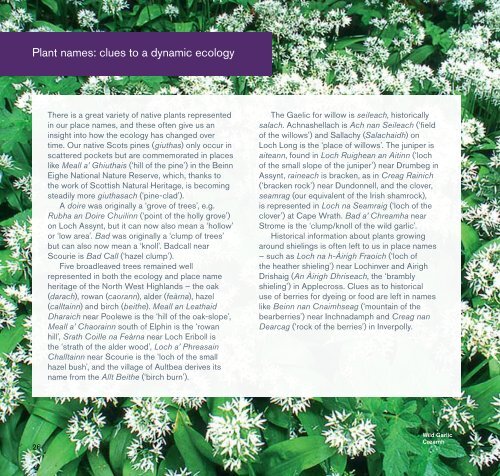You also want an ePaper? Increase the reach of your titles
YUMPU automatically turns print PDFs into web optimized ePapers that Google loves.
Plant names: clues to a dynamic ecology<br />
There is a great variety of native plants represented<br />
<strong>in</strong> our place names, and <strong>the</strong>se often give us an<br />
<strong>in</strong>sight <strong>in</strong>to how <strong>the</strong> ecology has changed over<br />
time. Our native Scots p<strong>in</strong>es (giuthas) only occur <strong>in</strong><br />
scattered pockets but are commemorated <strong>in</strong> places<br />
like Meall a’ Ghiuthais (‘hill of <strong>the</strong> p<strong>in</strong>e’) <strong>in</strong> <strong>the</strong> Be<strong>in</strong>n<br />
Eighe National Nature Reserve, which, thanks to<br />
<strong>the</strong> work of Scottish Natural Heritage, is becom<strong>in</strong>g<br />
steadily more giuthasach (‘p<strong>in</strong>e-clad’).<br />
A doire was orig<strong>in</strong>ally a ‘grove of trees’, e.g.<br />
Rubha an Doire Chuil<strong>in</strong>n (‘po<strong>in</strong>t of <strong>the</strong> holly grove’)<br />
on Loch Assynt, but it can now also mean a ‘hollow’<br />
or ‘low area’. Bad was orig<strong>in</strong>ally a ‘clump of trees’<br />
but can also now mean a ‘knoll’. Badcall near<br />
Scourie is Bad Call (‘hazel clump’).<br />
Five broadleaved trees rema<strong>in</strong>ed well<br />
represented <strong>in</strong> both <strong>the</strong> ecology and place name<br />
heritage of <strong>the</strong> North West Highlands – <strong>the</strong> oak<br />
(darach), rowan (caorann), alder (feàrna), hazel<br />
(callta<strong>in</strong>n) and birch (bei<strong>the</strong>). Meall an Leathaid<br />
Dharaich near Poolewe is <strong>the</strong> ‘hill of <strong>the</strong> oak-slope’,<br />
Meall a’ Chaora<strong>in</strong>n south of Elph<strong>in</strong> is <strong>the</strong> ‘rowan<br />
hill’, Srath Coille na Feàrna near Loch Eriboll is<br />
<strong>the</strong> ‘strath of <strong>the</strong> alder wood’, Loch a’ Phreasa<strong>in</strong><br />
Challta<strong>in</strong>n near Scourie is <strong>the</strong> ‘loch of <strong>the</strong> small<br />
hazel bush’, and <strong>the</strong> village of Aultbea derives its<br />
name from <strong>the</strong> Allt Bei<strong>the</strong> (‘birch burn’).<br />
The Gaelic for willow is seileach, historically<br />
salach. Achnashellach is Ach nan Seileach (‘field<br />
of <strong>the</strong> willows’) and Sallachy (Salachaidh) on<br />
Loch Long is <strong>the</strong> ‘place of willows’. The juniper is<br />
aiteann, found <strong>in</strong> Loch Ruighean an Ait<strong>in</strong>n (‘loch<br />
of <strong>the</strong> small slope of <strong>the</strong> juniper’) near Drumbeg <strong>in</strong><br />
Assynt, ra<strong>in</strong>each is bracken, as <strong>in</strong> Creag Ra<strong>in</strong>ich<br />
(‘bracken rock’) near Dundonnell, and <strong>the</strong> clover,<br />
seamrag (our equivalent of <strong>the</strong> Irish shamrock),<br />
is represented <strong>in</strong> Loch na Seamraig (‘loch of <strong>the</strong><br />
clover’) at Cape Wrath. Bad a’ Chreamha near<br />
Strome is <strong>the</strong> ‘clump/knoll of <strong>the</strong> wild garlic’.<br />
Historical <strong>in</strong>formation about plants grow<strong>in</strong>g<br />
around shiel<strong>in</strong>gs is often left to us <strong>in</strong> place names<br />
– such as Loch na h-Àirigh Fraoich (‘loch of<br />
<strong>the</strong> hea<strong>the</strong>r shiel<strong>in</strong>g’) near Loch<strong>in</strong>ver and Airigh<br />
Drishaig (An Àirigh Dhriseach, <strong>the</strong> ‘brambly<br />
shiel<strong>in</strong>g’) <strong>in</strong> Applecross. Clues as to historical<br />
use of berries for dye<strong>in</strong>g or food are left <strong>in</strong> names<br />
like Be<strong>in</strong>n nan Cnaimhseag (‘mounta<strong>in</strong> of <strong>the</strong><br />
bearberries’) near Inchnadamph and Creag nan<br />
Dearcag (‘rock of <strong>the</strong> berries’) <strong>in</strong> Inverpolly.<br />
26<br />
Wild Garlic<br />
Creamh


